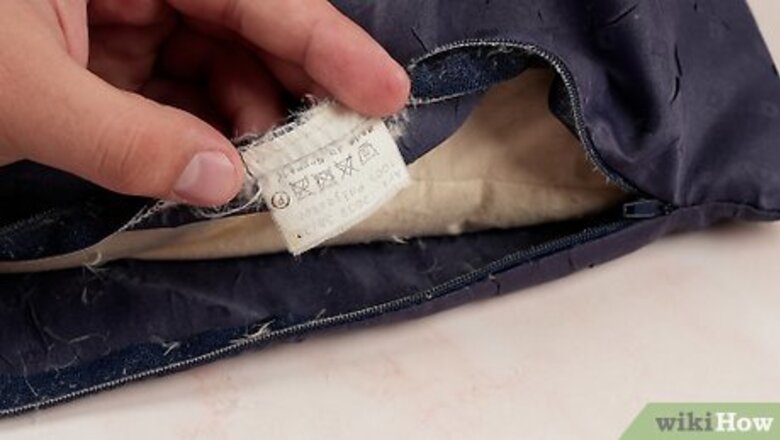
views
- Remove the cases and spot treat any yellow stains with a commercial stain remover. Let it sit for 15 minutes before wiping it away with a damp cloth.
- Machine-wash pillows with 1 cup (240 mL) of dish soap, 0.5 cups (120 mL) of laundry detergent, ¾ cup (6 oz) of washing soda, and 0.5 cups (120 mL) of white vinegar.
- Hand-wash yellow pillows by soaking them in warm water and 1 cup (240 mL) of bleach, then in a separate basin of cool water and 0.5 cups (120 mL) of mild detergent.
Machine Washing Yellow Pillows
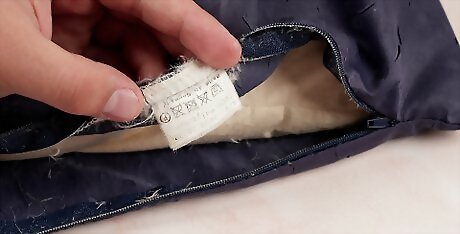
Remove the pillowcases and check the pillow’s care tag. As a basic rule of thumb, always check care tags before laundering something. While most pillows are machine washable, some might require dry clean or spot cleaning only, as either the fabric or the pillow’s filling will degrade in the wash. Generally, you can launder down and polyester pillows. Avoid laundering foam, latex, or bamboo pillows. Before you pop it in the wash, make sure your pillow doesn’t have a symbol of a basin of water with a hand in it. This symbol indicates that the pillow is hand-wash only. This applies to most foam pillows. Similarly, a basin of water with an “X” through it indicates that you should never wash the pillow yourself. Take it to a dry cleaner instead. Washing a pillow contrary to the care tag may void any warranties, or could even release toxins, in the case of some foam pillows.
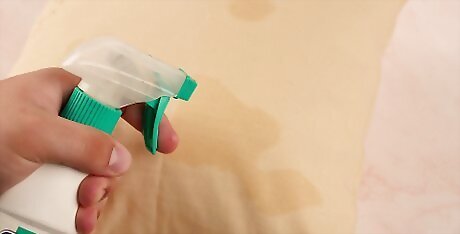
Spot treat any miscellaneous stains with a textile stain remover. Spray any food, makeup, or other stains with a commercial stain remover to loosen them before the wash. This also helps loosen the yellow stains caused by sweat or other bodily substances. Saturate the spot with your cleaner, let it sit for about 15 minutes, then wipe the cleaner away with a rag soaked in warm water. Or, mix 1 tbsp (6 g) of baking soda with 2 tablespoons (30 mL) of water to make a simple paste to substitute for a commercial cleaner.
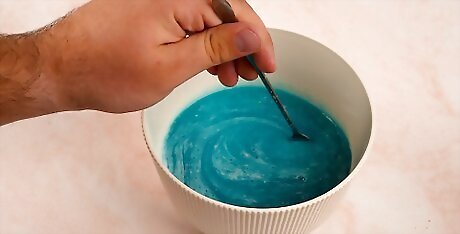
Launder pillows with laundry detergent, dish soap, vinegar, and washing soda. Your standard detergent may not be strong enough to rid your pillow of the yellow. To help it whiten up those pillows when washing them in a machine, add 1 cup (240 mL) of dishwasher soap, ¾ cup (6 oz) of washing soda, 0.5 cups (120 mL) of white vinegar, and 3 tbsps (44mL) of regular laundry detergent. Place these ingredients in the drum of your machine. Or, add 0.5 cups (120 mL) of your standard detergent and an equal amount of white vinegar, if you don’t have those supplies. Alternatively, launder your pillows with 0.5 cups (120 mL) of laundry detergent, ¼ cup (45 g) of borax, and 0.25 cups (59 mL) of bleach in the drum for a stronger clean. Only wash 2 pillows at a time for a thorough clean that’s easy on your laundry machine.
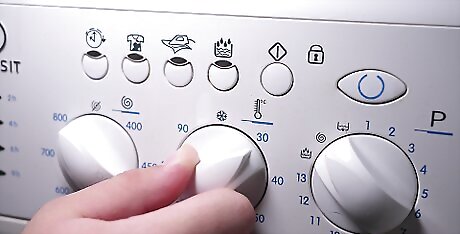
Wash polyester pillows on a delicate, warm cycle. Or, wash your down or feather pillows on a cool, delicate cycles. Pillows are surprisingly fragile, and depending on the material, water that’s too hot may degrade the stuffing or fabric. When in doubt, a delicate, cool cycle will do the trick.
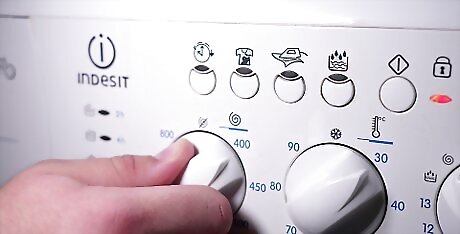
Run a second cycle with just warm water. The mixture above can be thick and grainy, and may adhere to pillows without a thorough rinse. After you’ve run a cycle with the mixture, run a second cycle with only warm water, or warm water and 0.5 cups (120 mL) of white vinegar. This will remove any remaining detergent, and will give your pillows a quick sanitizing session. If your pillow is still yellow after the first cycle, run another cycle with the same solution. If it doesn’t whiten after a second wash, the color may be permanent.
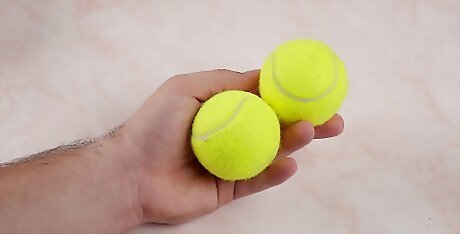
Dry the pillow on medium heat with a couple of tennis balls. Even smart washers aren’t very good at figuring out when a dense pillow is dry. Instead, dry it for 2 cycles on medium heat, and throw in a towel to speed up the process. Also toss in a couple of tennis balls to prevent the stuffing from bunching up. To dry a feather pillow, use a no-heat, air-dry setting, since intense heat can damage the stuffing. After, let the pillows dry near an open window for 3-4 hours to make sure they’re completely free of moisture before you put the pillowcases back on.
Hand Washing Yellow Pillows
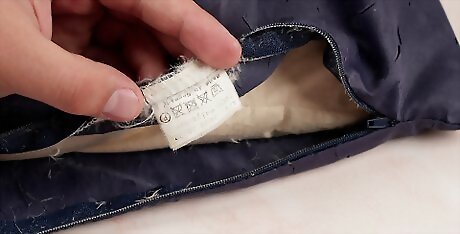
Check the care tags to make sure you can wash the pillow. Only soak and submerge down, feather, or polyester pillows. If you have a down or memory foam pillow, do not ignore the warnings printed on the label, as the materials in these pillows are not water safe. Instead, use spot treatments alone, or bring it to a dry cleaner. Do not soak any pillow that has the symbol of a basin with an “X” through it, which indicates the pillow may not be washed or is dry-clean only.
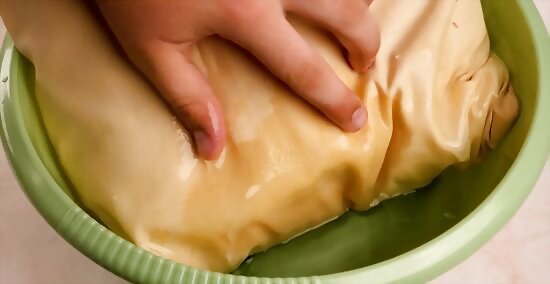
Soak the pillow in a basin with cool water and 1 cup (240 mL) of bleach. Fill a plastic tub or another container with cool water, then mix in your bleach. Place the pillow inside, and let it soak for 30 minutes. Soaking a pillow this way knocks the yellow stains loose, and makes it easier for a simple wash with detergent to remove the stains more completely. Only use bleach if the care tag indicates it’s safe for the pillow with a triangle symbol. If the triangle has an “X” through it, add 1 cup (240 mL) of dishwasher detergent, ¾ cup (6 oz) of washing soda, 0.5 cups (120 mL) of white vinegar, and 3 tbsps (44mL) of regular laundry detergent to the basin instead.
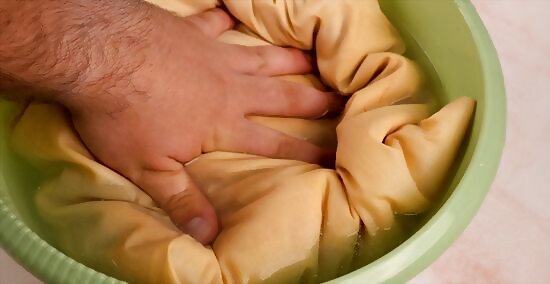
Squeeze the pillows in a basin with cool water and gentle detergent. To wash pillows by hand, fill a basin with cool water and add about 0.5 cups (120 mL) of a mild detergent, and mix it with your hands. One at a time, place your pillows in the basin and squeeze them 3-7 times each, allowing the detergent to work its way through all of the material, then rinse the pillows under cool water and squeeze them out to dry. Use this method for down, feather, or polyester pillows, which can typically be soaked. Do not wring or twist your pillow, as this can damage the stuffing or the fabric.
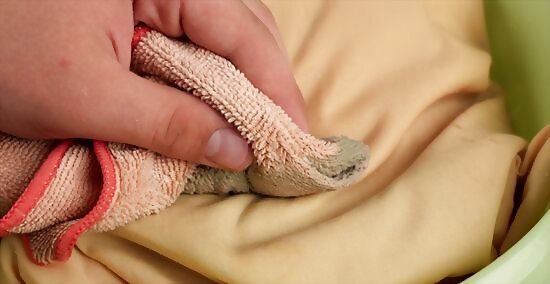
Wipe the pillow down with a soapy rag if you can’t submerge it in water. Wet a rag with warm water, then soak it in about 2 tablespoons (30 mL) of a gentle laundry detergent. Use the rag to wipe down the yellow spots on the pillow. Make sure not to saturate the pillow with moisture—just firm, quick swipes with the rag. Work until all the yellowed spots have been dampened. Use this method to wash bamboo pillows, or memory foam or latex pillows, which typically can’t get soaked with water. Use a vacuum cleaner with a brush attachment to remove any dust from the surface of the pillow before you wet it.
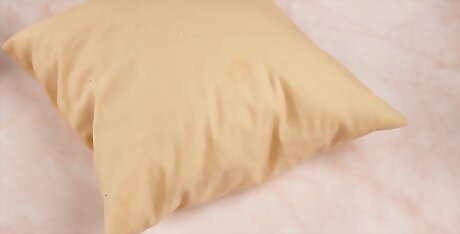
Let the pillows air dry for at least 24 hours. Place your pillows near an open window or a fan to help the moisture evaporate. If you can, place them in direct sunlight, which will help to further bleach the yellow color out. Flip the pillows every couple of hours to let both sides dry evenly. If the care tag doesn’t depict a circle inside a square with an “X” through both, feel free to tumble dry your pillows on a no-heat setting for 2 hours to dry them more quickly. To boost the sun’s bleaching power, spray the pillow all over with several spritzes of lemon juice.
Keeping Your Pillows White
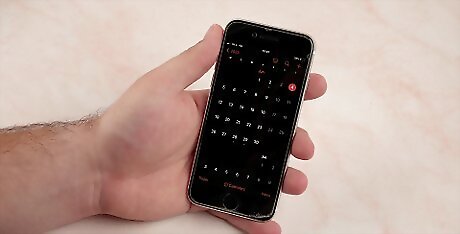
Wash your pillowcases once a week, and the pillows 2-4 times a year. To keep your pillows free of oils, dander, and other allergens, toss the cases (and the rest of your sheets) into the laundry every 7 days, along with 0.5 cups (120 mL) of mild detergent. If the bed’s owner is prone to sweating or wearing makeup to bed, change the sheets and pillowcases twice per week. Keep at least 2 sets of sheets on hand—1 on your bed, and 1 at the ready when laundry day rolls around. Regularly rotating your sheets keeps your mattress and pillows clean and helps your sheets last longer.
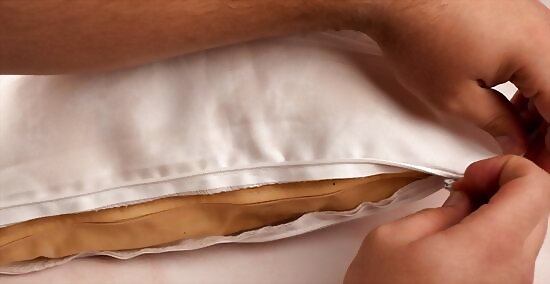
Cover your pillows in a pillow protector to prevent yellowing. A pillow protector is an added barrier that keeps oils, sweat, and other particles away from the pillow itself. Cover the pillow with the protector, then place your pillowcase over both. Wash the protector each week along with the pillowcase, or according to its specific care instructions on the label.
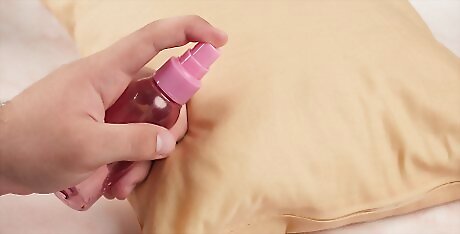
Use linen spray between washes to keep your pillow smelling fresh. Spritz your pillows all over once a week. Many linen sprays are made from safe, fresh ingredients such as witch hazel or essential oils, many of which can be tailored to suit your preferences. A quality linen spray won’t just mask odors, but also lift them from the fabric with antibacterial ingredients. Make your own linen spray by combining 1.5 fluid ounces (44 mL) of distilled water, 1.5 fluid ounces (44 mL) of vodka, and 30 drops of lavender essential oil in a small spray bottle. Linen sprays can double as sleep aids; a spray using lavender or cedarwood oil, for instance, may help you relax and get to sleep.
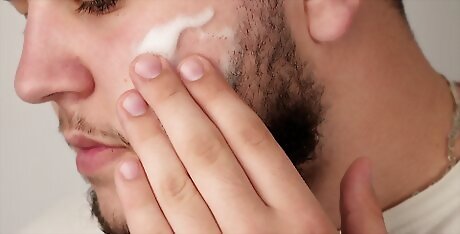
Go to bed with a fresh face to keep oils off the pillows. You don’t have to shower each and every night, but quickly wash your face and brush your hair to cut down on the oils and dandruff that make their way into your pillows. Many cosmetic ingredients are harsh and can not only discolor fabric, but also break fabric down. Even doing something as simple as splashing water on your face and tying your hair back can extend your pillows’ life.

















Comments
0 comment